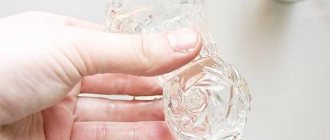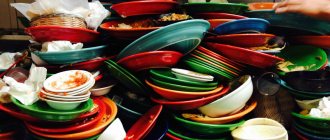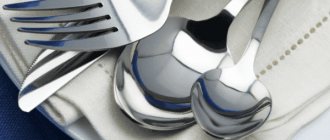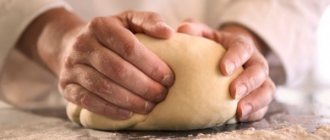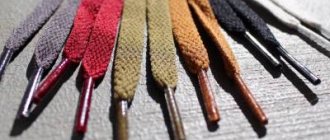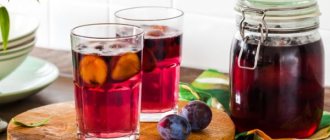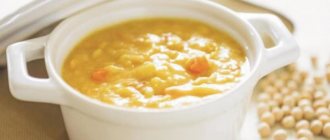Washing dishes is a daily necessity that everyone faces regularly. Regardless of whether you prefer to wash plates, spoons and cups right away or wait until more accumulate, the question of how to quickly wash dishes remains relevant and pressing. Every housewife has in her arsenal several proven tricks that help wash dishes until they shine quickly and effectively. How to wash dishes correctly, and what products are best to use?
Ways to speed up washing dishes by hand
Despite the variety of different techniques, the most common method of cleaning dishes is still hand washing. This is the most economical method, allowing you to save water, electricity, and cleaning products that are used when washing dishes in the dishwasher. But hand washing takes time; it can be significantly reduced if you use simple tips.
Soaking
To quickly wash dishes, you need to pre-soak them, so the dirt will soften and the process will speed up significantly. Before soaking, remove all large food debris from the plates. For soaking, use a special container (basin, bowl) or kitchen sink, having previously plugged the drain. Add a little detergent to the water and leave the dishes to soak for 10-20 minutes.
Sorting dishes
To quickly wash dishes, they are usually sorted. This need is due to the fact that cups, cutlery, pots and plates have varying degrees of contamination. Cups, glasses, glasses are washed first - they are the least dirty and do not come into contact with fat. If they were used only by family members, it is enough to rinse the cups with a sponge and hot water, without adding detergent. When glasses are used by guests, they are washed with detergent to protect household members from possible bacteria and germs left on the dishes.
You can also wash cutting boards without adding detergent. They are washed with hot running water if dry, low-fat products (baked goods, non-juicy fruits and vegetables) were cut. When cutting meat or fish, the boards must be soaked, washed with detergent, and, if desired, disinfected with vinegar.
Cutlery comes next in line. To clean forks, spoons, and knives, you will need hot water and detergent. Then they begin to wash the plates, and at the final stage - pots, pans, cauldrons. Thus, the dishes are sorted, starting from the lightest contaminants and ending with the most complex and labor-intensive stage of work.
Before washing dishes, it is recommended to sort them
The right choice of detergents and cleaning products
Any modern housewife has a wide variety of detergents and cleaning products. Among them are the following funds:
- hypoallergenic;
- softening the skin of the hands;
- does not contain synthetic surfactants;
- intended for washing dishes in cold water;
- powdery (for heavy soiling);
- liquid economical gels (with a lot of foam).
Liquid detergents are good for washing plates, cups, cutlery, and glassware. They are economical to use, but after using gels, the dishes need to be washed thoroughly, since these products do not wash off quickly and leave behind toxic substances. If you need to wash heavily soiled dishes, use cleaning powder. Most often it is used to clean cauldrons, pots, and some types of frying pans (depending on the type of surface).
For stainless steel and ceramics, the use of powders is unacceptable - they will damage the surface being cleaned. In this case, gels, liquids and traditional methods of washing kitchen utensils are used.
It is recommended to choose a detergent taking into account the material from which the dishes are made
Don't pile up too many dishes in the sink
To quickly and correctly wash dishes by hand, as a rule, they are rinsed immediately after eating, leaving a minimum of dirty kitchen utensils for later. Fresh, not yet dried stains are washed off much faster. Mountains of dishes lying in the sink for a long time begin to emit a fetid odor, forcing the housewife to postpone the unpleasant process until later.
Try not to accumulate too many dishes in the sink
Two pan method
This method saves water and time. You need to take two rather large pans, place one directly in the sink, and place the other next to it. Pour hot water into the first pan and add detergent. Use it to clean dishes using a sponge. Pour cold water into the second pan, here the dishes are washed with a sponge without detergent. Finally, plates, kitchen utensils and cups are rinsed under running water.
Other tips
To quickly wash dishes at home, you do not need to have the skills of a professional dishwasher. But if you want to reduce your kitchen cleaning time, listen to the advice of the professionals.
If the washing process does not give you any pleasure, do the work while listening to pleasant, relaxing music. You'll see, in a week your attitude towards cleaning the kitchen will change.
How to wash dirty dishes faster:
- Fight Plyushkin syndrome. Do not accumulate a lot of dishes in the sink, otherwise the procedure will 100% turn into a real hell. It is very difficult to wash food that has dried on the plates, so try not to put it off for too long.
- Maintain the order. You can wash dishes faster if you start with small cutlery, glasses, bowls and saucers. They get dirty the least, so they don’t require soaking.
- Fighting odors. Even if you wash your forks and plates with detergent, the smell of fish or onions will linger for at least a day. To get rid of it, soak the utensils in a weak vinegar solution.
- Two pan method. Place two small pots or bowls in the sink. Warm water with detergent is poured into one, and clean cold water into the second. In the first, dirty utensils are washed, and in the second, the remaining gel is removed. After processing, all dishes should be washed under running water.
Washing dishes is a whole science that anyone can master. Using the advice of professionals, you will be able to turn torment over the sink into full-fledged meditation.
The washing up
10-15 minutes after soaking, proceed directly to washing.
It is worth starting the process with the least contaminated dishes - glasses, glasses, plates for low-fat foods. Afterwards, the more soiled plates and bowls are washed. You should handle pans and pots last.
To save detergent, it is recommended to wash the maximum number of devices with one drop. After applying the product to the sponge, it must be squeezed several times, making foam. Wipe each device with the prepared sponge. Then start rinsing the washed dishes.
Some housewives make an unforgivable mistake for the family budget: they take one serving item, wash it with a product and rinse it with the same sponge soaked in the product. This way it is washed off both from the dishes and from the sponge at the same time. And it has to be applied again every time.
How to quickly wash dishes by hand
Washing dishes is a separate discipline of the household, which undeservedly receives little attention. Neglecting the rules for sorting, soaking and processing dirty pans, cups, plates, bowls, and pots leads to unnecessary loss of precious time. Not all housewives know how to properly wash dishes by hand, so the task turns into a real challenge for them.
According to experts, it takes no more than 25-30 minutes to wash a mountain of greasy dishes. Surely most housewives doubted the veracity of the data, but it is so. The secret lies in the algorithm for performing work, sorting household utensils, and the quantity and quality of detergents used.
Sort and wash in order
Washing dishes always begins with sorting kitchen utensils. To make your work easier, it is recommended to fold separately:
- dishes;
- cups;
- frying pans;
- forks;
- large bowls;
- pots;
- spoons.
Sorting and washing in order is the fastest and most effective way to clean the kitchen. In order not to stain more or less “clean” plates and glasses, pots and pans are washed at the very end. Then the fat in them will drain into the empty sink, so you won’t have to wash soapy cups, forks, etc.
Poorly washed off fat is a challenge for most women. To avoid trouble, use high-quality detergents:
- Fairy;
- Sonett;
- Somat Gold;
- Frosch;
- Klar;
- Zero;
- Sodasan Dishwashing Liquid;
- Dual Power Dishwasher Gel Green Life.
To keep washed utensils squeaky clean, use only hot water. Then the plates will shine and the sink siphon will not become clogged with grease.
Soak in a sink or large basin
Before washing dishes, remove food debris from plates, bowls, and pans. To avoid spending hours cleaning kitchen utensils, start working immediately after lunch or dinner. If you leave dirty dishes for a couple of hours, it will be difficult to scrape off any congealed grease or sauce.
If you nevertheless allowed yourself to relax, which you have every right to, and did not start washing the dishes right away, do not be upset. Soaking will save you from hanging over the sink for many hours:
- remove any remaining food;
- sort the utensils;
- wash the sink of grease;
- close the drain hole with a plug;
- fill the sink with water;
- add 50 ml of detergent to it;
- shake until foam forms;
- Place dishes in the sink.
Remembering Archimedes' principle, fill the sink only halfway with water. Otherwise, when immersing the plates, the soapy water will splash.
After 20-30 minutes, the remaining food will become soaked and can be easily removed with a sponge soaked in detergent.
Do not pour excess detergent
Before washing dishes, determine the amount of detergent needed. To wash 20 plates, you will need no more than 1-2 g of gel diluted in ½ liter of warm water. By not saving on dishwashing detergents, women think that they will deal with stains faster, but this is not the case.
Why you shouldn’t soak your sponge generously in detergent concentrate:
- more than 40% of the gel simply falls into the sink without having time to be useful;
- plates treated with a large amount of gel are difficult to wash;
- It takes a lot of time to rinse soapy kitchen utensils.
To clean dirty plates from grease, but without wasting time on removing the detergent itself, you need:
- pour 250 ml of warm water into a bowl;
- add a couple of drops of detergent;
- shake with a fork;
- Periodically dip the sponge into the solution.
If necessary, cleaning agents are added to the solution. This need arises at the very end, when it remains to wash pots and pans with stuck-on food residues.
Pause in time
Train yourself and your family members to clear plates of leftover food before putting it in the sink. Then use the following method: place the dishes in a large bowl or basin, fill with hot water and add a couple of drops of detergent. It’s easier to wash plates and pans from old grease.
You can do without bowls: put the dishes in the sink, closing the drain, and leave them to soak in hot water. Don't mix everything together!
If there is no heavy contamination, you should not use detergent and then use water to thoroughly rinse.
Now you have 10-15 minutes to check personal messages, calls or fill the cat with food. After which it would be good to remember that you are a champion and wash the dishes easily.
Sometimes there are too many dishes. For such cases, they practice the one soap sponge rule: wash with a sponge until it stops foaming. Then they pause, switching to another activity. The technique has long been known - a long distance divided into stages is easier to overcome. During a break, some people make the mistake of eating from clean plates again, which only adds more dishes.
How to optimize your dishwashing process
Correctly organizing any type of activity, including caring for kitchen utensils, means reducing to a minimum the time spent and the consumption of materials for the work. The following actions have a significant impact on the effectiveness of the washing process.
- The habit of washing plates and cutlery immediately after eating should be made mandatory in housekeeping. On dishes that are not washed on time, food residues dry out and will be much more difficult to remove. The option in which each of the people who jointly manage the household cleans up after themselves is a good incentive in resolving the issue.
- Before you start washing the dishes, you need to get rid of any food residue on them. Use paper napkins to collect them from the plates into a trash bag. If the washing process takes place in the sink, pre-cleaning will ensure free flow of water and the siphon will not become clogged.
- If for some reason you cannot wash the dishes right away, you should soak them in a container with water and detergent. After this soaking it will become easier to wash.
Rice. 1 — Sponge-brush for washing dishes
- Avoid using rags as washing aids (for example, unwearable knitwear or worn-out bed linen). Use special foam sponges that absorb the cleaning gel well, which means they are more effective in their work. Periodically, sponges require replacement as fat deposits accumulate. It is recommended to change them every week. Use metal braided sponges to remove dried food.
- Do not stack dirty dishes. It is better that the plates are not tightly adjacent to one another. Then the surfaces that are not in contact with food (mostly the lower parts of the plates) will not get dirty. And this way it will be easier to wash them.
- When washing a large number of dishes, sort them first. Arrange separately by type: spoons, knives, forks, plates, mugs, pots - divide everything. Wash each type without mixing with others. Practice has shown significant time savings with this division.
- To save water, turn off the tap while treating the surface with gel. And after all items have been rubbed with detergent, turn on the tap and start rinsing.
- A bowl of water with a small amount of it dissolved will help reduce the consumption of detergent. Instead of applying gel to a sponge, soak it in this solution. The quality of washing will not deteriorate from this. You should not waste detergent on dishes that have not been touched by greasy or, say, dyed food. You can simply rinse this one with water, and that will be enough.
- In the absence of industrial detergents, you can do without this chemical. At home, use traditional methods that will successfully cope with the task of bringing plates or crystal to a shine.
- If you have to wash dishes frequently, try to improve your skills each time, analyze your actions creatively and, by choosing the most effective methods, reduce the washing time.
- In order not to aggravate the already unpleasant process of washing dishes, perform it with gloves and preferably an apron. Then you won’t have to do any extra work of lubricating your hands with cream and cleaning your clothes.
Many experienced housewives have their own secrets on how to quickly wash dishes. We present the most optimal accumulated methods and photos. These tips are suitable for anyone who has to wash by hand without using a dishwasher.
Rice. 2 - Dishwashing gloves
Review of the best products
You can get rid of unpleasant odors, wash kitchen utensils so they shine, and remove stains from coffee and other drinks using universal products. You can use proven methods and not waste time. There are different types of dishwashing detergents. They differ in manufacturers and composition. There are a number of folk methods that help cope with pollution better than household chemicals.
From improvised means
If a regular detergent doesn’t do the job, an old, proven life hack comes to the rescue for creating a handy solution. Mustard, citric acid, ammonia, laundry soap, washing powder, soda and table salt are suitable for this.
The action of each resource separately:
- Mustard powder. Rub the dirty dishes with mustard powder and leave the container for 15-20 minutes. Wipe with a kitchen sponge and rinse in warm water.
- Ammonia. Ammonia helps to cope even with old, ingrained contaminants. Place a few drops of alcohol on a kitchen sponge and rub the dirty areas with it. Rinse the utensils in warm water.
- Lemon acid. Remove the soaked dishes from the basin and rub with citric acid. Let the container stand for 20-30 minutes, wash with detergent and rinse with warm water.
- Laundry soap. Rub laundry soap into hot water and soak dirty utensils in the prepared liquid. Rinse each container in clean, hot water, then rinse thoroughly to remove any remaining product.
- Soda. Soda contains abrasive particles that remove old grease or scale. Clean with the hard side of the sponge, rubbing the utensils with baking soda. After rinsing, cups, pots and other items in the kitchen will shine.
- Salt. Heat table salt and rub dirty containers with it. Leave for 20 minutes and then wash thoroughly using detergent.
Using baking soda, you can easily clean your microwave, oven, or other kitchen items. You can use sand, apple essence, table vinegar, and wood ash to clean burnt areas on aluminum cookware.
Specialized
Household chemical stores have a large selection of kitchen products. The difference lies in price, manufacturer, composition. They are available in the form of powder, gel, tablets. Dishwashing detergents contain surfactants that provide foaming.
It all depends on the additional components included in the detergent. Salts of inorganic acids are added to the composition to help remove grease and other contaminants. Enzymes, which are additives, allow you to remove poorly soluble protein contaminants. A good quality product is easily washed off the surface of kitchen utensils. Children's dishes should be washed using special products that do not contain hazardous chemicals.
The process of washing dishes is not difficult, but tedious and monotonous. Consider the basic rules of this procedure, the type of material, and choose the right cleaning agents. You can cope with your daily work quickly and efficiently.
Part 1. How to wash dishes by hand economically and correctly
There are many daily worries. And washing dishes is one of them.
Everyone does this every day and more than once.
Let's see how and what you can save on this reusable activity - how to wash dishes by hand economically and correctly.
How to wash dishes by hand economically and correctly. What can you save on?
I wrote about saving my home budget there before.
I'll give you this star
It was about saving as a way of life. But let us remember not only that “what is saved is the same as what is earned,” but also that “everything is good in moderation.” Today we’ll talk about what good habits to develop when washing dishes.
If you analyze the entire process of washing dishes by hand, you can see that you can save:
- detergent
- cleaning material - sponge, for example
- water
- its time
So let's go
Prepare the dishes for washing in no time
Let’s take our time to wash every plate.
Since Soviet times, when there was no need to count water, many housewives have become accustomed to keeping the kitchen in order all the time.
Yes! This was also associated with cockroaches and flies, which were, frankly speaking, too many.
Hence the habit of keeping plates, pots, cups washed and dry.
If there is such a problem even now, then we need to think about how to collect dirty dishes for “wholesale” washing and, at the same time, not give any chance to outside living creatures to feed on them. Possible solutions are a plastic container, a sealable bucket,... well, it's a test of intelligence.
The main idea is to collect the dishes and wash them 1 or 2 times a day.
At the same time, it is better to clean it from food residues immediately - let it lie unwashed, but without such residues.
On the count of two - before washing, arrange the dishes according to the type of dirt and type of dish.
This means putting them into groups before washing:
- not greasy - cups, glasses, saucers, compote jars, colander, ...
- plates, saucers from which fatty foods were eaten
- spoons, forks, knives, spatulas, skimmers, whisks - in general, all the little things
- the most difficult dishes to wash - pots, pans, baking dishes, baking sheets
Put on an apron, if you haven't already, and gloves, if you're used to protecting your hands.
All! Ready for washing!
Let's start washing
The next stage depends on the size of the sink - if the size of the sink is not very different from the basin, then we will wash in it, if it is much larger, then it is better to put a basin and wash in it. I wash it in the sink.
The sequence is:
— I plug the hole in the sink with a stopper
— turn on the water a little hotter with warm, gentle pressure
— I put all the small items from the “spoons, forks, knives” group on the bottom. Let them soak
— while the water is gathering quickly, wash and immediately rinse low-fat dishes from the “cups, glasses, saucers” group with running water
As a result, by the end of the water supply in the sink, approximately halfway, one group of dishes will be washed and stand upside down to drain on the auxiliary platform of the sink.
It is more convenient to wash this group not with a sponge, but with a soft, water-absorbing cloth - cotton knitwear is ideal.
It is better to keep clean old robes and nightgowns cut into pieces of suitable sizes in a cabinet next to the sink. This is so that as the rag becomes greasy, you can quickly and without regret replace it with a new one. How these pieces are obtained was written in an article about saving on old things.
How to wash dishes by hand economically and correctly- the water was turned off, the washed and drained dishes were put away in storage areas, there is no need to waste time on wiping, if you don’t have such a “fad” as dry dishes - let them dry on their own.
Due to the size of the article, it was necessary to divide it into 2 parts. Therefore, how to properly wash dishes by hand further and how it all ends, you need to read here.
DIY gifts for the Year of the Rat
Part 2. How to wash dishes by hand economically and correctly
Part 3. How to wash dishes by hand economically and correctly
How to wash dishes with complex stains using folk remedies
Dishes are cleaned depending on the type of dirt. To wash greasy bowls, pots and plates, use only gel. But complex pollution is much more difficult to deal with. To quickly wash kitchen utensils, they use life hacks from experienced housewives.
How to clean dishes with stubborn stains:
- Nagar. Soot often appears on the bottom of pans, which cannot be removed with washing gel. To wash dishes easily, treat problem areas with toothpaste. After 30 minutes, dirt can be easily removed with a sponge.
- Boiled milk and dried dough. First, very dirty dishes should be washed under running cold water. When the contaminants begin to linger, turn on the hot water.
- Fat. To remove greasy marks on pots, pans or plates, use laundry soap. To enhance the fat-dissolving effect, mile chips are mixed with soda in a 3:1 ratio. Dissolve 4 tbsp in ½ liter of warm water. l. mixtures. To wash the utensils, use a regular sponge soaked in the solution.
How to clean dishes with centuries-old plaque:
- Soda Ash. 15 g of powder is dissolved in 1 liter of water. Use it to wash enamel pots or stainless steel items.
- Dry mustard. A solution of ½ liter of hot water and 3 tbsp will help you easily wash cutlery. l. dry mustard. Forks, spoons, and knives are soaked in it for at least 30 minutes, after which they are rinsed with cold water.
- Stationery glue. Fill a saucepan with 5 liters of water and place it on the stove. After 5 minutes, add 50 ml of office glue, 2 tbsp. l. laundry soap shavings. Place cutlery and shallow plates into the solution for 10-15 minutes. After removing dirt, wash the dishes under running water.
- Vinegar and citric acid. To wash stainless steel or aluminum products, prepare a special solution. 25 g of citric acid and 150 ml of vinegar essence are dissolved in 1 liter of hot water. Soak a sponge in the solution and treat contaminated surfaces.
The situation is worse with decanters, which cannot be penetrated with a sponge. To wash glass utensils, fill it 1/3 with soapy water and add 1 tbsp. l. eggshell. Holding the hole tightly, shake the decanter thoroughly several times, after which the soap solution is drained.
Complex contaminants
It’s good if everything is washed on the same day, but what to do with old stains, how to get rid of them. There are several secrets here too.
- Soapy water will help get rid of carbon deposits and grease. You need to soak dirty utensils in it for 35-40 minutes, then remove them and wash them with a sponge and detergent. Or you can make a paste of baking soda, salt and water, apply it to the dirt and leave it overnight. Wash it all off in the morning.
- To get rid of the unpleasant smell of fish, you can use salt. It is necessary to warm it up and then apply it for 30-40 minutes. After this, rinse with warm water.
- You can clean the steamer using its same functions. Just pour water into it and turn on “steaming”. 15 minutes is enough for all the fat to come off.
- Gilded porcelain saucers and cups can be washed well with a solution of ammonia, and baking soda will help get rid of brown deposits.
- Aluminum frying pans and pots can be washed well using a special solution: 80-100 g of office silicate glue, previously dissolved in water, is added to 1-1.5 buckets, then soda ash is added. Boil for half an hour and leave in this solution until it cools completely.
- It is good to wash dishes with a narrow neck using soapy water, paper or shells.
- Residues of milk and eggs can be easily removed by first rinsing them with cold water.
- The baking sheets are easy to clean with baking soda or a damp powder. Then rinse, dry and heat in the oven.
If you know some tricks and use them, then washing dishes will no longer be so long and scary. Use these tips to learn how to quickly wash dishes and make your life easier.
Mine in the right order
Proper dishwashing routines reduce cleanup time by preventing dirtier kitchen utensils from staining relatively clean items. The procedure should be as follows:
- Mugs for tea or coffee, glasses and wine glasses for other drinks.
- Dinner and soup plates.
- Salad bowls and common serving dishes from the dining table.
- All cutlery and small utensils: spoons, forks, knives, ladles, spatulas, graters.
- Large and heavily soiled items: frying pans, pots, baking trays and baking dishes. It is better to soak them in water with a few drops of detergent immediately after use.
- Utensils and equipment with a strong odor, for example, after cutting fish.
Sorting dishes
To quickly wash dishes, they are usually sorted. This need is due to the fact that cups, cutlery, pots and plates have varying degrees of contamination. Cups, glasses, glasses are washed first - they are the least dirty and do not come into contact with fat. If they were used only by family members, it is enough to rinse the cups with a sponge and hot water, without adding detergent. When glasses are used by guests, they are washed with detergent to protect household members from possible bacteria and germs left on the dishes.
You can also wash cutting boards without adding detergent. They are washed with hot running water if dry, low-fat products (baked goods, non-juicy fruits and vegetables) were cut. When cutting meat or fish, the boards must be soaked, washed with detergent, and, if desired, disinfected with vinegar.
Cutlery comes next in line. To clean forks, spoons, and knives, you will need hot water and detergent. Then they begin to wash the plates, and at the final stage - pots, pans, cauldrons. Thus, the dishes are sorted, starting from the lightest contaminants and ending with the most complex and labor-intensive stage of work.
Before washing dishes, it is recommended to sort them
Features of washing various dishes and the choice of detergents
How to wash dishes made of various materials so as not to harm them:
- Crystal products
do not tolerate too hot water. However, it is not recommended to clean them with hard sponges or use products with abrasive particles. Sometimes it is enough to wipe such dishes with a soft cloth soaked in a solution of alcohol or vinegar, then rinse and polish dry with a soft piece of cloth. - When there is a need to wash frying pans or pots with an enamel surface
, you should avoid using hard brushes and sponges, which can damage the enamel. It is not recommended to use hot water, and there is also no need to create a temperature difference to prevent the coating from cracking. - For cast iron utensils,
regular warm water and detergent will do, but you should wash them immediately and do not leave them wet. Then such dishes should be coated with oil, and the excess should be wiped off with paper napkins. Cast iron cookware is stored oily. - Any aluminum products
are easily coated when exposed to an acidic environment. Therefore, to clean them, it is better to use traditional methods of washing dishes, and then wipe the kitchen utensils dry so that the metal does not deform under the influence of residual moisture. - In order to understand how to wash glassware
, you need to consider the type of glass from which it is made. If the product has a fire-resistant coating, then it should not be filled with cool water if the glass has not yet cooled down. Otherwise, the dishes may burst. Metal sponges are not suitable for cleaning such utensils. If ordinary glassware gets dirty, just wipe it with a soapy sponge and rinse with warm water. - Products with a glazed coating or designs
porcelain
dishes, require careful handling. If water is too hot, the coating may burst and the designs may crack. Therefore, the washing process should be carried out exclusively in water no higher than 35 degrees and using soft cellulose napkins or microfiber sponges. - Clay and ceramics
are washed from food residues using regular soap. In this case, the water temperature should be room temperature, and after washing such items should be wiped dry to avoid the occurrence of an unpleasant odor from the dishes. - Kitchen utensils with non-stick coatings
, such as Teflon frying pans, do not tolerate the impact of harsh cleaning utensils. They are cleaned only with the soft side of the sponge, soaping it generously. - Plastic products
for the kitchen do not tolerate high temperatures. Therefore, it is recommended to wash them with warm water. Very cold water will not allow you to wash off most detergents from the surface of the products, and the rinsing procedure will have to be repeated up to five times.
In addition to taking into account the characteristics of the materials from which cutlery and dishes are made, it is also important to choose the right detergent. This is especially true when it is necessary to wash products intended for children.
The best way to wash dishes: nuances of choosing a detergent
- If the washing process is carried out exclusively by hand, then preference should be given to factory-made products that contain lemon, aloe and other components that prevent the negative effects of hard water on the skin of the hands.
- How to wash children's kitchen utensils? Among purchased products, it is better to give preference to gels designed specifically for children's dishes. For example, it produces a line of “Eared Nannies” products, among which there is a detergent for washing children’s dishes. It effectively fights dirt, and is easily washed off without covering the surface of kitchen products with a soapy film and without leaving behind an odor.
- When choosing a “chemical” dishwashing detergent, you need to first familiarize yourself with its composition, which should contain a minimum amount of negative components and surfactants.
- When the question arises: what is better for washing dishes: gel or powders, preference should be given to the first option. It's universal. You cannot use powder detergents on certain types of cookware, such as glass, porcelain, silver or aluminum. Small abrasive particles leave microscopic damage on the surface of products. This leads to cracks, chips, and the dishes become unusable.
How to clean pans and pots from burnt food
What to do when a forgotten frying pan or pan burns, but you don’t want to buy a new one? There are several ways to help save your family budget:
Method No. 1
Teflon-coated dishes can be easily washed off from burning and soot. You need to fill it with water for half an hour and then rinse.
Method No. 2
Clear the frying pan of food residues, place it on the stove and heat to high temperature. Fill the bottom of the hot frying pan with a full glass of warm water. Wipe off the carbon deposits with a wooden spatula. For final cleaning, boil water in a bowl with a small amount of detergent for 10-20 minutes.
Method No. 3
Sprinkle half a cup of salt evenly onto the burnt bottom. Leave for several hours, then wash off any burning and soot. Clean a cast-iron frying pan with salt immediately while it is hot, otherwise the fumes will set in deeply. This method is good for stainless steel dishes, but abrasive pastes and powders will ruin them.
Method No. 4
Used when milk has run out. Grind activated carbon and add water. After 15 minutes, dirt can be easily removed.
Method No. 5
Many housewives prefer to solve the problem with vinegar and soda. Moreover, they are always at hand in any kitchen. It is better to clean aluminum cookware with baking soda. Aluminum loses its appearance due to many other substances.
We collect all dirty dishes in one place at once
To ensure that kitchen cleaning occurs as quickly as possible, it is worth doing the preparatory work:
- Collect all dirty dishes. It can be located not only on the kitchen or dining table, but also in other places where household members prefer to eat and drink tea. First, you should go through all the rooms and collect all the dirty plates and cups.
- Prepare your workplace. All funds should be at hand. You will need gloves, a sponge, dishwashing gel and a means to remove complex stains (a hard grater or special household chemicals).
- Adjust the water to a suitable temperature, put on rubber gloves and only then start washing.
The washing location cannot be changed
Look at the sink in your home through the eyes of a stranger, a guest - a boring place, devoid of personality. And it doesn’t always meet hygiene standards - an old sponge is adjacent to a new one, a fresh towel hangs next to a napkin with greasy stains.
Get into the habit of immediately dealing with untidy-looking kitchen utensils.
Decorative elements in the kitchen interior will not be out of place: a small detail above the sink or next to it, a stylish, funny little thing. Any souvenir will do, as long as it evokes good, personal emotions. It’s not a big deal, but now it’s nice to go to the sink.
Be sure to decide on a constant set of items on and around the work surface. These things catch your eye many times a day, so keep only the necessary and cute ones. The main thing is that you don’t have to look for anything, and everything is at hand - from rubber gloves to soft towels. Then you can quickly wash the dishes with your own hands in between times, during a commercial break or while waiting for the tea to brew.
